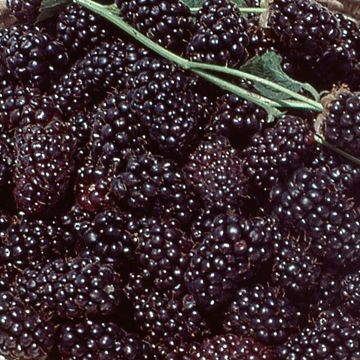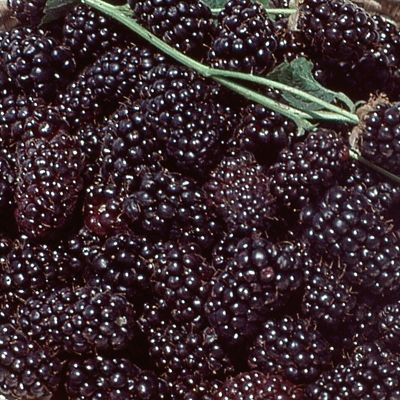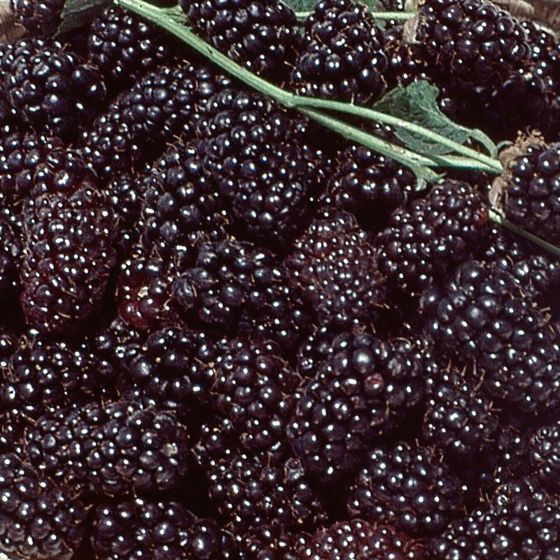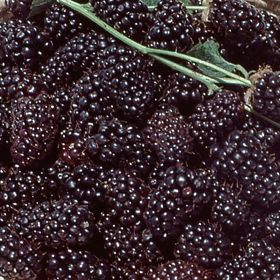Boysenberry Plant
Description
About Boysenberry Plants
The Boysenberry plant is known for producing large, juicy, dark purple berries that are used for baking delectable desserts and making wonderful jam. This is a hybrid plant, having blackberry, raspberry, loganberry, and dewberry in its parentage. It is a bramble, and its scientific classification is rubus ursinus x rubus idaeus.
The Boysenberry was developed by Rudolph Boysen in Anaheim, California, in the 1920’s. It was another berry farmer in the area, however, who popularized the fruit--Walter Knott of Knott’s Berry Farm in Buena Park. Mr. Knott began growing the berries in the early 1930’s, and his wife, Cordelia Knott, made them into jams and pies. The popularity of her cooking with Boysenberries (and her famous fried chicken) led in large part to the eventual development of the amusement park known today as Knott’s Berry Farm.
This vining bramble produces small white flowers in the spring. The plant grows thin, thorny canes from its fibrous roots.
Stark Bro’s Boysenberries are from the original Boysen cultivar.
The Fruit
Boysenberries are larger and sweeter than blackberries, but comparable to them and raspberries in taste.
Enjoy this rare treat! Boysenberries are not typically found in grocery stores, due to their fragility. This also means that the berries should be processed quickly after harvest. One common way to do so is by making jams and jellies.
Use Boysenberries to bake delicious treats like cakes, pies, and turnovers. Add as a flavoring for ice cream, cream cheese, or pancakes. And don’t forget to use these sweet berries in savory dishes, where sauces can compliment roasted pork or beef.
Boysenberries contain anthocyanins, which are antioxidants found in plants that contain dark red coloring. They are high in vitamin C and also contain vitamins K and E, manganese, copper, and magnesium.
Growth and Care
Boysenberries are one of a group of brambles known as trailing blackberries, meaning the plant needs to be supported by a trellis system. The other type is erect, which does not need outside support. Boysenberries can be successfully grown in pots, with proper trellis support.
Plant Boysenberries in full sun and well-drained soil. Water the plant at its base to avoid fungus growth. This plant is heat tolerant and self-pollinating. It is not cold-hardy, so be sure to check its USDA zone compatibility. To protect them during the occasional frost, plants should be covered with hay or other insulating materials.
Plants should start producing berries in one to two years. Harvest is in late July. Pruning should be done following the harvest in late autumn over the winter.
Buy a Boysenberry plant and enjoy an abundance of deliciously sweet, dark purple berries!
Survival Guaranteed!


Since 1816, Stark Bro’s has promised to provide customers with the very best fruit trees and plants. It’s just that simple. If your trees or plants do not survive, please let us know within one year of delivery. We will send you a free one-time replacement, with a nominal shipping fee of $9.99. If the item in question is not available, we can issue a one-time credit to your account equaling the original product purchase price or issue you a refund. Read more about our warranty policy.
Characteristics
| Bloom Color | White |
| Fruit Color | Purple |
| Fruit Size | Extra Large |
| Hardiness Zone Range | 6 - 9 |
| Pollination | Self-Pollinating |
| Ripens/Harvest | Late July |
| Shade/Sun | Full Sun |
| Soil Composition | Loamy, Sandy |
| Soil Moisture | Well Drained - Average Moistness |
| Soil pH Level | 6.0 - 6.5 |
| Taste | Sweet |
| Texture | Firm |
| Years to Bear | 1 - 2 |
Size & Spacing
Mature Size
Recommended Spacing
Zone Compatibility
Pollination
This variety is self pollinating.
Tools & Supplies
Planting & Care
Learn all about how to grow hybrid berry plants in The Growing Guide. An entire section of our website dedicated to your growing success.




